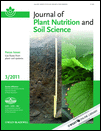Application of the DNDC model to predict N2O emissions from sandy arable soils with differing fertilization in a long-term experiment
Abstract
Modeling crop growth and soil N dynamics is difficult due to the complex nature of soil–plant systems. In several studies, the DNDC model has been claimed to be well-suited for this purpose whereas in other studies applications of the model were less successful. Objectives of this study were to test a calibration and validation scheme for DNDC-model applications to describe a field experiment with spring wheat on a sandy soil near Darmstadt (SW Germany) using different fertilizer types (either application of mineral fertilizer and straw—MSI; or application of farmyard manure—FYM) and rates (low—MSIL, FYML; and medium—MSIM, FYMM). The model test is based on a model parameterization to best describe the case MSIL and applies this parameterization for a retrospective simulation of the other cases (MSIM, FYML, FYMM) including crop growth and N2O emissions. Soil water contents were not accurately simulated using either the DNDC default values for a loamy sand or for the next finer texture class or using results from the pedotransfer function provided by ROSETTA. After successful calibration of the soil water flow model using a soil texture class that led to the best fit of the measured water content data, grain yield of spring wheat and cumulative N2O emission were slightly underestimated by DNDC and were between 91% and 86% of the measured data. A subsequent calibration of the yields and cumulative N2O emissions from soils of the MSIL treatment gave a good prediction of crop growth and N2O emissions in the MSIM treatment, but a marked underestimation of yields of the FYM treatments. Cumulative N2O emissions were predicted well for all MSI and FYM treatments, but seasonal dynamics were not. Overall, our results indicated that for the sandy soil in Germany, site-specific calibration was essentially required for the soil hydrology and that a calibration was useful for a subsequent prediction where greater amounts of the same fertilizer were used, but not useful for a prediction with a different fertilizer type.




